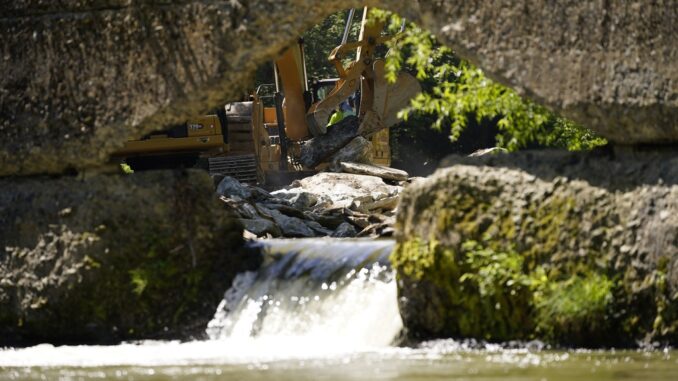
BOONE — An infusion of hundreds of millions of dollars from a federal infrastructure law is helping expedite efforts to remove dams around the country. Advocates expect the law will provide more than $2 billion to repair and remove dams and other barriers. Many groups are already using that money to remove mostly small dams from North Carolina to California. Advocates argue removing these structures, many of which have outlived their usefulness and are in desperate need of repair, can return rivers to their natural state and bolster biodiversity. Others are being removed to reduce the risk of floods and revive river economies.
North Carolina — which had the second-largest collection of dams in poor or unsatisfactory condition — set aside $7.2 million for the removal of Watauga County’s Shulls Mill Dam and at least five others in the western part of the state.
Removal of this privately owned hydropower dam in western North Carolina will allow the river to flow freely for nearly 80 miles, a boon for rafters, kayakers and tubers. But the biggest beneficiary may be a strange, ancient creature known as the eastern hellbender salamander.
Sometimes called a snot otter or Allegheny alligator, it’s North America’s largest salamander and can reach two feet in length. However, the salamander’s range in places such as southern Appalachia has shrunk, and its numbers have decreased by 70% over the past 50 years.
“What’s so important about the hellbender is they need special habitat — clear, clean, cold, heavily oxygenated water,” said Andy Hill, a Watauga Riverkeeper with MountainTrue, which teamed up with American Rivers to remove the dam in July. “The hellbender is kind of a keystone species for a mountain stream ecosystem, and removal of this dam will create a new habitat.”
Demolition of Shulls Mill Dam is part of a national trend to return rivers to their natural state by removing aging, sometimes derelict structures that once powered mills, irrigated farmland or impounded water. Aimed at boosting biodiversity, improving water quality and strengthening flood protection amid worsening storms, the campaign to demolish dams dates back several decades. Still, it has intensified with a once-in-a-generation funding infusion from the $1 trillion bipartisan infrastructure bill.
Appalachian State University’s Michael Gangloff, coordinating biological monitoring at the Shulls Mill site, said the free-flowing river should improve water quality and become more attractive to salamanders. Sediment will be flushed downstream, he said, exposing larger rocks and boulders where salamanders live, lay eggs and raise young.
“We should see better habitat conditions around the dam and, in 10 to 15 to 20 years, it will be hard to tell there was a dam there,” Gangloff said.


